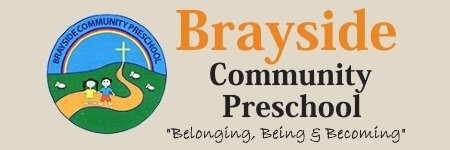Areas of Learning at Brayside Community Preschool
Through observation and conversations educators create spaces that offer deeper opportunities to explore, learn, relate and imagine. The Early Years Learning Framework outlines five Outcomes children achieve when engaged in intentional and evolving play spaces. Outcomes are woven throughout Brayside’s learning environments and are achieved within each of the spaces.
Art
Children: think creatively and critically, express feelings, collaborate, tell stories, make meaning, problem solve, communicate.
Develop skills: fine motor, creative self-expression, develop descriptive language and storytelling, elements of art: shape, colour, proportion, tone, texture, size and space. This may look like painting, drawing, cutting, building and sculpture, colour mixing, claywork, tactile experiences and discussing artworks.
Literacy
The capacity, confidence and disposition to use language in all its forms, including music, movement, dance, storytelling, visual arts, media and drama, as well as talking, listening, viewing, reading and writing.
Educator’s resource, scaffold and model how to use and engage with literacy in meaningful ways in children’s play. Learning is embedded in the environment and experience rather than taught as a discrete and separate skill.
STEM
Science, Technology, Engineering and Maths may look like building with blocks, conducting experiments, predicting outcomes, counting and ordering, measuring, exploring liquid or dry materials, recording information, researching using books or computers, experimenting with cause and effect and trial and error, observing and investigating nature, using our senses, exploring tools, sound and light, and using technical language. As well as games and puzzles.
Blocks / Construction
Building and creating in our block area encourages spatial awareness, balance, fine motor manipulation and strength, encourages thinking and reasoning and collaboration between peers. Building develops focus and patience, creativity and problem-solving skills and lends itself to support mathematical concepts such as tall and short, large and small, heavy and light as well as 2D and 3D shape.
Multicultural
Culture represented in art experiences, music, role play spaces and literacy bring the wider world to our preschool and into children’s lives. Children develop a sense of belonging to groups and communities and learn to respond to diversity with respect. We acknowledge the Gumbayngiir people as caretakers of our land and invite families to share their home culture with our preschool community.
Reality Play
These environments might mirror places children visit in the community, with family or imaginary places. Children can explore the lives of other people and re-create their own experiences by dressing up, or being a doctor, a vet, a scientist, a father, an astronaut etc. Reality play is brain and vocabulary building, encourages emotional and social development, conflict resolution skills and developing empathy and collaboration.
Exploratory
Including sensory play, small world imaginary play, resources and materials that invite open ended play experiences, loose parts, construction and deconstruction, nature play and senses.
Spontaneous / Children’s Ideas
Our learning environment is a direct expression of our knowledge and understanding of the children in our care. As children play, question and investigate ideas educators adapt environments to support that playful exploration. Resources and areas change as we grow and change as learners and friends.
